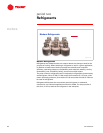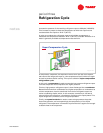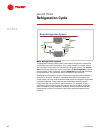
TRG-TRC003-EN 19
period three
Refrigeration Cycle
notes
The liquid refrigerant absorbed heat from the air while it was inside the
evaporator, and was transformed into a vapor in the process of doing useful
cooling. Earlier in this clinic, we demonstrated that if the heat is then removed
from this vapor, it will transform (condense) back to its original liquid phase.
Heat flows from a higher temperature substance to a lower temperature
substance. In order to remove heat from the refrigerant vapor, it must transfer
this heat to a substance that is at a lower temperature. Assume that the
refrigerant evaporated at -41.4°F [-40.8°C]. To condense back into liquid, the
refrigerant vapor must transfer heat to a substance that has a temperature less
than -41.4°F [-40.8°C]. If a substance were readily available at this cooler
temperature, however, the refrigerant would not be required in the first place.
The cooler substance could accomplish the cooling by itself.
How can heat be removed from this cool refrigerant vapor, to condense it, using
a readily-available substance that is already too warm for use as the cooling
medium? What if we could change the temperature at which the refrigerant
vapor condenses back into liquid?
5HIULJHUDWLRQ6\VWHP
UHIULJHUDQW
UHIULJHUDQW
YDSRU
YDSRU
OLTXLG
OLTXLG
UHIULJHUDQW
UHIULJHUDQW
)
)
>&@
>&@
VXEVWDQFH
VXEVWDQFH
FROGHUWKDQ
FROGHUWKDQ
)
)
>&@
>&@
KHDW
KHDW
Figure 30


















